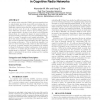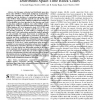718 search results - page 127 / 144 » Opportunistic Relaying in Wireless Networks |
MOBICOM
2009
ACM
15 years 4 months ago
2009
ACM
In cognitive radio networks (CRNs), spectrum sensing is key to opportunistic spectrum access while preventing any unacceptable interference to primary users’ communications. Alt...
ICC
2007
IEEE
15 years 4 months ago
2007
IEEE
With the advent of cognitive radio technology, new paradigms for spectrum access can achieve near-optimal spectrum utilisation by letting each user sense and utilise available s...
126
click to vote
TMC
2008
14 years 9 months ago
2008
Integrating mobile computing and localized user interaction into the Internet requires more than simply overcoming pure routing challenges. Apart from issues such as intermittent c...
GLVLSI
2009
IEEE
15 years 4 months ago
2009
IEEE
Recently, cooperative communication has attracted a lot of attention for its potential to increase spatial diversity. However, limited attention has been paid to the physical laye...
TIT
2010
14 years 4 months ago
2010
In this paper, collocated and distributed space-time block codes (DSTBCs) which admit multigroup maximum-likelihood (ML) decoding are studied. First, the collocated case is conside...


